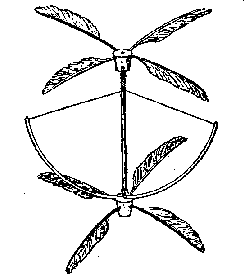|

This description of the helicopter model originally appeared in the
November 1809 issue of "Nicholson's Journal" as part of a paper
called "On Aerial Navigation" written by Sir George Cayley. It's
been slightly abridged for this website.
"...it may be an amusement to some of your reader to see
a machine rise in the air by mechanical means [and] which anyone can
construct at the expense on 10 minutes labour.
There are two corks, into each of which are inserted four wing
feathers, from any bird, so as to be slightly inclined like the sails of
a windmill, but in opposite directions in each set. A round shaft,
which ends in a sharp point, is fixed in the top cork. At the upper part
of the bottom cork is fixed a whalebone bow, having a small pivot hole
in its centre, to receive the point of the shaft. The bow is then to be
strung equally on each side to the upper portion of the shaft, and the
little machine is completed.
Wind up the string by turning the flyers differents ways, so that the
spring of the bow may unwind them with their anterior edges ascending.
Then place the cork with the bow attached to it upon a table, and with a
finger on the upper cork press strong enough to prevent the string from
unwinding, and taking it away suddenly, the instrument will rise to he
ceiling. This was the first experiment I made upon this subject in the
year 1796."
The source of this
material is the book "Sir George Cayley's Aeronautics
1796-1855" by Charles Gibbs-Smith, published by Her Majesty's
Stationery Office, London, UK, in 1962. Copies of the book may be found at www.bookfinder.com.
|
